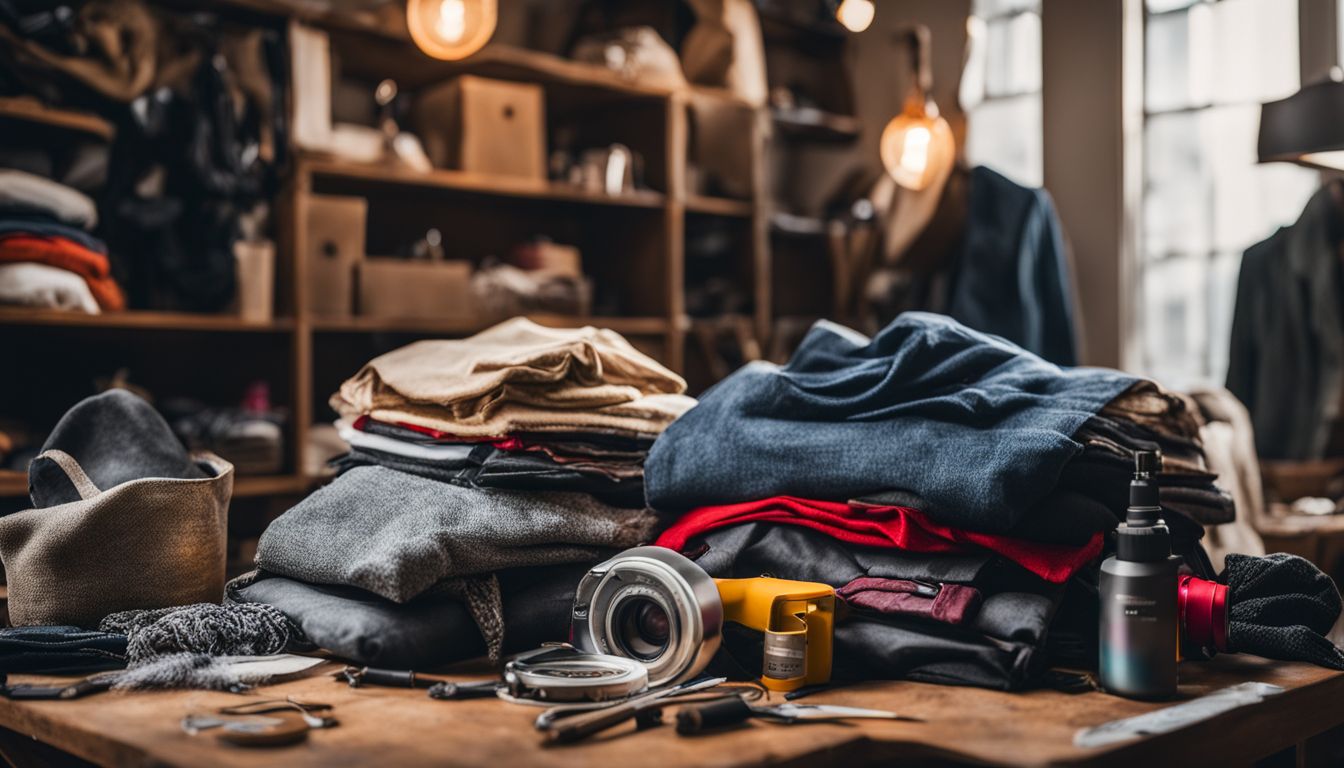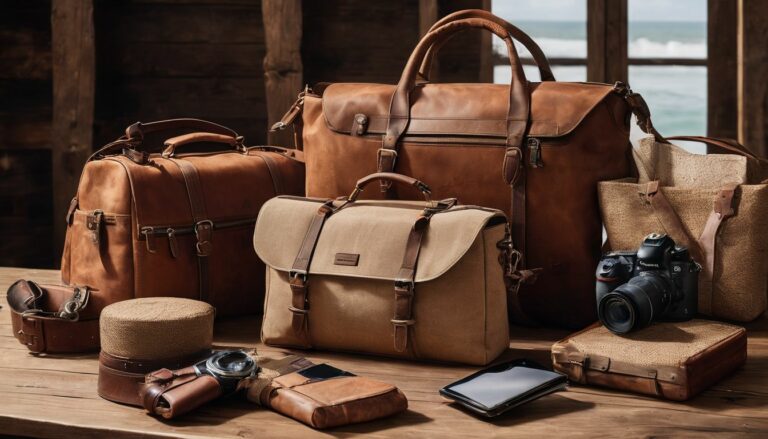The Ultimate Guide to Starting a Successful Upcycling Clothes Business
Starting a successful upcycling clothes business can be a daunting venture, yet it’s a booming industry due to the increasing demand for sustainable fashion. The fashion sector produces 10% of all humanity’s carbon emissions and is responsible for nearly 20% of global wastewater.
This article will empower you with an ultimate guide on how to start your own lucrative upcycling fashion business, steering clear from these negative impacts. Let’s dive in and explore how transforming old garments into trendy pieces can both profit your pocket and protect our planet!
Key Takeaways
- Upcycling is a creative way to give old clothes new life and value, without breaking them down too much like recycling does.
- Research your competition and choose a niche market that aligns with your skills and interests to stand out in the crowded sustainable fashion industry.
- Create a comprehensive business plan that outlines your goals, target market, marketing strategies, budget, pricing strategy, production process, and sustainability practices.
- Form a legal entity and register your upcycling business while handling taxes and finances by keeping track of income/expenses, understanding tax obligations/sales tax/income tax laws, hiring an accountant/bookkeeper, budgeting for startup/ongoing costs separately from personal finances.
- Set prices strategically based on material costs/production expenses/desired profit margin/competition/market demand/target market preferences.
- Consider startup costs (materials/tools/store space/website setup/business registrations/licenses) and ongoing expenses (restocking materials/tool maintenance/monthly rent/utilities/website hosting fees/license renewals).
- Acquire necessary equipment for your production line according to requirements.
What is Upcycling and How Does it Differ from Recycling?

Upcycling is a creative way to reuse old things. It means giving a new life and value to what is not used anymore. Let’s talk about clothes, for example. You can turn an old t-shirt into a tote bag or make hair ties from worn-out dresses.
In short, upcycling adds more worth to the clothes you have.
But how does upcycling differ from recycling? Recycling often breaks down items into raw stuffs again. It might turn paper back into pulp or melt plastic down before reshaping it. Upcycling doesn’t do that, instead it reworks the item without breaking it down too much.
So in a way, upcycling gives our old things a fun twist!
Research and Planning for Your Upcycling Business

Research the competition, choose a niche market, create a business plan, brand your business, and identify your target market.
Researching the competition

To start a successful upcycling clothes business, it’s important to research your competition. Look at other upcycled fashion brands and see what they’re doing. Find out who their target market is and how they brand themselves.
This will help you choose a niche market for your own business and develop a unique selling point. Remember to also identify your target market so you can tailor your products and marketing efforts towards them.
By researching the competition, you’ll gain valuable insights that can inform your business plan and help you stand out in the crowded marketplace of sustainable fashion.
Choosing a niche market

To start a successful upcycling clothes business, it’s important to choose a niche market. This means finding a specific group of people who are interested in your upcycled products.
You could focus on upcycling vintage clothing or creating eco-friendly children’s clothing, for example. By choosing a niche market, you can tailor your designs and marketing efforts to meet the needs and preferences of that particular group.
This will help you stand out from the competition and attract customers who are passionate about your unique offerings. So take some time to research different niches within the upcycling industry and find one that aligns with both your skills and interests as well as what customers are looking for in sustainable fashion.
Creating a business plan

Creating a business plan is an important step in starting a successful upcycling clothes business. Here are some key points to consider:
- Determine your goals and objectives for the business.
- Conduct market research to understand your target audience and competition.
- Define your niche market and identify unique selling points for your products.
- Outline your marketing strategies, including online platforms, social media, and collaborations.
- Establish a budget and financial projections for startup costs and ongoing expenses.
- Develop a pricing strategy that considers materials, labor, and desired profit margins.
- Detail your production process, including sourcing materials and transforming them into upcycled garments.
- Consider sustainability practices in your business operations and communicate these values to customers.
Branding your business

When starting a successful upcycling clothes business, it’s important to focus on branding. Branding helps you stand out and attract customers. Consider the values and image you want your business to portray.
Think about what makes your upcycled fashion unique and how you can communicate that to your target market. Develop a compelling brand name, logo, and visual identity that reflect the essence of your business.
Utilize social media platforms to showcase your products, share genuine stories about your creations, and build a loyal following. Remember that branding is an ongoing process – consistently deliver high-quality upcycled garments with quirky styling to reinforce your brand identity.
Identifying your target market

To start a successful upcycling clothes business, it’s important to identify your target market. This means understanding who your ideal customers are and what they want. Consider factors such as age, gender, location, and interests.
For example, if you’re creating upcycled clothing for young adults who are passionate about sustainable fashion, you can tailor your designs and marketing strategies to appeal to them.
Researching trends in the fashion industry and conducting surveys or interviews with potential customers can also help you gather valuable insights. By knowing who your target market is, you can effectively reach out to them and offer products that meet their needs and preferences.
Setting Up Your Upcycling Business

To set up your upcycling business, you will need to form a legal entity, handle taxes and finances, set prices, consider startup costs and ongoing expenses, open a business bank account, obtain necessary permits and licenses, purchase business insurance, create a website or choose a platform to sell your upcycled products, and acquire the necessary equipment for your production line.
Forming a legal entity and registering your business

To start your upcycling clothes business, you need to form a legal entity and register your business. Here are the steps to follow:
- Choose a business name: Pick a unique and catchy name for your upcycling clothes business.
- Decide on the business structure: Determine whether you want to operate as a sole proprietorship, partnership, limited liability company (LLC), or corporation.
- Register your business: File the necessary paperwork with the appropriate government agency to register your business. This may include obtaining an Employer Identification Number (EIN) from the Internal Revenue Service (IRS).
- Obtain any required permits and licenses: Depending on your location and the type of products you plan to sell, you may need specific permits or licenses. Research and apply for any necessary certifications or permissions.
- Set up a separate bank account: Open a dedicated bank account for your upcycling clothes business to keep your personal and business finances separate.
- Consider getting insurance: Protect yourself and your business by obtaining appropriate insurance coverage, such as liability insurance or product liability insurance.
Handling taxes and finances

Starting a successful upcycling clothes business involves handling taxes and finances. Here are some important things to consider:
- Keeping track of your income and expenses: Maintain detailed records of all financial transactions related to your business, including sales, expenses, and investments.
- Understanding tax obligations: Familiarize yourself with the tax laws and regulations that apply to your upcycling business. This includes knowing which taxes you need to pay, such as sales tax or income tax.
- Hiring an accountant or bookkeeper: Consider hiring a professional who can help you manage your finances and ensure compliance with tax requirements. They can also provide valuable advice on maximizing deductions and reducing tax liabilities.
- Budgeting for startup and ongoing costs: Create a budget that outlines your expected expenses, such as equipment purchases, materials, marketing efforts, and operating costs. This will help you track your spending and make informed financial decisions.
- Setting prices strategically: Determine the right pricing strategy for your upcycled products that takes into account both production costs and market demand. Consider factors like quality, uniqueness, and competition when determining the value of your items.
- Separating personal and business finances: It’s crucial to keep personal and business finances separate by opening a dedicated business bank account. This will simplify financial management, help with accurate record-keeping, and streamline tax reporting.
Setting prices

Setting prices for your upcycled clothing business is an important step in ensuring profitability. You need to consider factors like the cost of materials, production expenses, and desired profit margin.
Conduct research on similar products in the market to get an idea of their pricing range. Additionally, consider your target market and their willingness to pay for upcycled garments.
Remember that while you want to make a profit, it’s also important to offer competitive prices that attract customers. Keep track of your costs and regularly assess whether your pricing strategy needs adjustment based on market demand and competition.
Considering startup costs and ongoing expenses

Starting an upcycling clothes business involves estimating startup costs and budgeting for ongoing expenses. These expenses can be broken down in the following way:
| Startup Costs | Ongoing Expenses |
|---|---|
| Materials for upcycling, such as old clothes and crafting supplies | Restocking of upcycling materials and supplies |
| Purchasing of essential tools like scissors, marking tool, and a variety of rulers | Maintenance and replacement of these tools |
| Leasing space for the store if you’re looking to operate in a physical location | Monthly rent payments and utilities |
| Setting up a website or an online selling platform | Website maintenance, hosting fees, and online selling platform fees |
| Business registrations, permits, and licenses | Renewal of these licenses and permits |
| Business insurance | Business insurance premiums |
| Initial marketing and advertising costs | Regular marketing and advertising expenses |
Remember, all businesses face some unforeseen expenses, and the upcycling clothes business is no exception. The key to success is efficient and effective financial planning and management.
Opening a business bank account

To open a business bank account for your upcycling clothes business, you’ll need to find a bank or credit union that offers business banking services. Look for one that suits your needs and offers low fees.
You will have to provide some documents, such as your business registration and identification, so make sure to gather them beforehand. Once you’ve chosen a bank, schedule an appointment with a banker to get started on the account opening process.
Opening a separate business account will help you keep your personal and business finances separate, making it easier to track expenses and manage cash flow.
Obtaining necessary permits and licenses
To start your upcycling clothes business, you will need to obtain the necessary permits and licenses. Here are the key steps to follow:
- Research the specific permits and licenses required in your area.
- Contact your local government or business development agency to inquire about the application process and any fees involved.
- Fill out the necessary forms and provide any required documentation, such as proof of identity or business registration.
- Submit your application to the appropriate department or agency.
- Follow up on your application to ensure it is processed in a timely manner.
- Once approved, display your permits and licenses in a visible location at your business premises.
Purchasing business insurance
To protect your upcycling clothes business, it’s important to purchase business insurance. This will help you in case of any unexpected events or accidents that could disrupt your operations.
Business insurance can cover things like property damage, liability claims, and even loss of income if you have to temporarily shut down. It’s a good idea to consult with an insurance agent who specializes in small businesses to make sure you have the right coverage for your specific needs.
By having this protection in place, you can focus on growing your business without worrying about potential risks.
Creating a website or choosing a platform to sell your upcycled products
To sell your upcycled products, you need to create a website or choose a platform. Here are some options:
- Build your own website using platforms like WordPress or Shopify.
- Use online marketplaces like Etsy, eBay, or Amazon Handmade to reach a wider audience.
- Consider niche platforms like Depop or Poshmark for selling secondhand and upcycled fashion items.
- Utilize social media platforms like Instagram or Facebook to showcase your products and drive traffic to your online store.
- Collaborate with influencers in the sustainable fashion community to promote your products on their platforms.
Acquiring the necessary equipment for your production line
To start your upcycling clothes business, you will need to acquire the necessary equipment for your production line. Here are some key items you will need:
- Sewing Machine: A reliable sewing machine is essential for stitching and altering garments.
- Serger/Overlock Machine: This machine helps you finish seams professionally and gives your garments a polished look.
- Iron and Ironing Board: An iron is crucial for pressing fabrics, ensuring smooth seams, and achieving a professional finish.
- Cutting Tools: Invest in good-quality scissors for cutting fabric accurately. You may also need rotary cutters, cutting mats, and pinking shears.
- Notions and Fasteners: Stock up on buttons, zippers, snaps, hooks, and other fasteners to complete your designs.
- Measuring Tools: Rulers, tape measures, and tailor’s chalk will help you measure and mark fabric accurately.
- Storage Solutions: Organize your fabrics, trims, and notions with shelves or storage bins to maintain an efficient working environment.
Marketing and Growing Your Upcycling Business

Develop a comprehensive marketing strategy to promote your upcycling business through various channels such as social media, online platforms, collaborations with influencers and local businesses, participation in craft fairs and markets, and building a loyal customer base.
Discover the secrets to growing your business and expanding your product offerings for maximum success.
Developing a marketing strategy
To successfully promote your upcycling clothes business, you need to develop a solid marketing strategy. Here are some key steps to consider:
- Define your target audience: Identify who your ideal customers are and create buyer personas to understand their needs and preferences.
- Build brand awareness: Utilize social media platforms like Instagram, Facebook, and Pinterest to showcase your upcycled products and engage with potential customers. Share high-quality images and videos that highlight the uniqueness of your creations.
- Collaborate with influencers: Partnering with influencers or fashion bloggers who align with your brand values can help increase visibility and reach a larger audience. Offer them free or discounted items in exchange for promoting your business on their platforms.
- Attend craft fairs and markets: Participating in local events allows you to connect directly with potential customers. Set up an attractive booth, display your best pieces, and interact with visitors to build relationships and generate sales.
- Offer incentives: Encourage repeat purchases by implementing loyalty programs or offering discounts to customers who refer others to your business. This can help build a loyal customer base and generate positive word-of-mouth.
- Leverage email marketing: Collect email addresses from interested customers and send regular newsletters featuring new product launches, special promotions, or behind-the-scenes content that showcases the creative process behind your upcycled garments.
- Showcase customer testimonials: Highlight satisfied customer reviews on your website or social media platforms to build trust among potential buyers.
Promoting your business through social media and online platforms
Promoting your upcycling clothes business through social media and online platforms is crucial for reaching a wider audience and increasing sales. Here are some effective ways to market your business online:
- Create engaging content: Share photos and videos of your upcycled creations to showcase your unique designs. Use storytelling to connect with customers and highlight the sustainability aspect of your business.
- Build a strong social media presence: Maintain active profiles on popular platforms like Instagram, Facebook, and Pinterest. Regularly post updates, respond to comments and messages, and engage with your followers.
- Collaborate with influencers: Partner with influencers or bloggers who align with your brand values. They can help promote your products to their followers and generate buzz around your business.
- Utilize targeted ads: Use paid advertising on social media platforms to reach specific demographics or locations. This can help you target potential customers who are interested in sustainable fashion or upcycling.
- Participate in online communities: Join relevant groups or forums where people discuss sustainable fashion or upcycling. Contribute valuable insights, answer questions, and share information about your business when appropriate.
- Offer exclusive discounts or promotions: Create special offers exclusively for your social media followers to encourage engagement and drive sales. This can help build a loyal customer base.
- Collaborate with other brands: Seek partnerships with complementary businesses such as eco-friendly accessory brands, ethical fashion bloggers, or sustainable lifestyle influencers. Co-promotion can expose your brand to new audiences.
Collaborating with influencers and local businesses
Collaborating with influencers and local businesses can greatly benefit your upcycling clothes business. Influencers are individuals who have a strong social media following and can help promote your brand to their audience.
By partnering with them, you can reach a wider customer base and increase brand awareness. Local businesses, on the other hand, offer opportunities for collaborations such as pop-up shops or joint events.
This allows you to tap into their existing customer base and gain exposure in the local community. Collaborating with influencers and local businesses not only helps boost sales but also builds credibility for your upcycling business.
Participating in craft fairs and markets
Participating in craft fairs and markets is a great way to showcase your upcycled clothing business. These events provide an opportunity for you to connect with customers face-to-face and share the unique stories behind your creations.
Craft fairs and markets attract a wide range of shoppers who appreciate handmade, sustainable products. By setting up a booth or table at these events, you can reach a larger audience and potentially gain new loyal customers.
It’s important to choose the right events that align with your target market and brand values. Make sure to bring plenty of inventory, display your items attractively, and engage with potential customers by sharing the process of how you transform materials into stylish, eco-friendly fashion pieces.
Building a loyal customer base
To build a loyal customer base for your upcycling clothes business, you need to focus on connecting with your customers and delivering excellent service. Engage with them through social media platforms and online communities that align with your target market.
Share genuine stories about the garments you upcycle and the positive impact of sustainable fashion. Offer personalized shopping experiences by providing styling tips or customization options.
Also, prioritize customer satisfaction by ensuring timely delivery and addressing any concerns promptly. By consistently delivering high-quality products and exceptional service, you can foster loyalty among your customers, resulting in repeat purchases and positive word-of-mouth recommendations.
Expanding your product offerings
To grow your upcycling clothes business, it’s important to expand your product offerings. By offering a diverse range of upcycled garments and accessories, you can attract more customers and increase sales.
Consider adding new styles, designs, and sizes to cater to different preferences. You can also experiment with incorporating unique materials or techniques that set your products apart.
Don’t forget to listen to customer feedback and stay updated on the latest fashion trends to ensure your expanded product line remains relevant and appealing.
Increasing Profitability and Sustainability

To increase profitability and sustainability, focus on maximizing profit margins, implementing sustainable practices in your production process, exploring partnerships with eco-friendly organizations, providing excellent customer service to develop a loyal customer base, continuously improving and innovating your upcycled products.
Maximizing your profit margins
To maximize your profit margins in your upcycling clothes business, there are several strategies you can implement. First, focus on reducing costs by sourcing materials from thrift stores or donations instead of purchasing new fabrics.
This will save you money while also aligning with the sustainable ethos of upcycling. Additionally, optimize your production process to minimize waste and improve efficiency. This could include streamlining your workflow, training employees on best practices, and investing in tools that help increase productivity.
Another way to boost profitability is by effectively pricing your products based on factors such as labor, materials, and market demand. Conduct market research to understand what customers are willing to pay for upcycled clothing items and adjust your prices accordingly.
Implementing sustainable practices in your production process
Implementing sustainable practices in your production process is crucial for the success of your upcycling clothes business. Here are some important steps to follow:
- Use eco-friendly materials: Opt for fabrics that are recycled, organic, or sustainably sourced. Avoid using materials that are harmful to the environment.
- Reduce waste: Minimize fabric waste by carefully planning and cutting patterns efficiently. Consider using scraps and leftover materials for smaller accessories or patchwork designs.
- Embrace zero-waste techniques: Explore creative ways to utilize every part of the fabric, such as making buttons or trimmings from scraps.
- Choose non-toxic dyes and finishes: Select dyes and finishes that are environmentally friendly and free from harmful chemicals.
- Energy-efficient production: Use energy-efficient machines and equipment to reduce energy consumption during the manufacturing process.
- Responsible packaging: Opt for packaging materials that are recyclable or biodegradable. Minimize excess packaging whenever possible.
- Collaborate with ethical suppliers: Partner with suppliers who prioritize fair trade practices and uphold high environmental standards.
- Promote recycling initiatives: Encourage customers to recycle their old clothing by offering incentives or providing a recycling program where they can return items for upcycling.
- Educate customers about sustainability: Share information with customers about the environmental benefits of upcycled fashion and the importance of supporting sustainable businesses.
- Constantly evaluate and improve: Regularly assess your production processes to identify areas for improvement in terms of sustainability practices.
Exploring partnerships with eco-friendly organizations
To increase your business’s sustainability and align with eco-friendly practices, you should explore partnerships with organizations that share the same values. These partnerships can provide you with valuable resources, support, and opportunities to collaborate on eco-conscious initiatives.
Look for organizations that focus on sustainable fashion, circular economy, or environmental conservation. By joining forces, you can create a stronger impact in promoting ethical and ecofriendly clothing options.
Such partnerships also help in expanding your network and reaching a wider audience who are passionate about sustainable fashion.
Developing a loyal customer base through excellent customer service
To build a loyal customer base for your upcycling clothes business, it’s essential to provide excellent customer service. This means offering friendly and helpful assistance to customers, addressing their concerns promptly, and going the extra mile to ensure their satisfaction.
By understanding and meeting the needs of your customers, you can build trust and loyalty. Providing personalized recommendations and offering special promotions or discounts can also help in fostering strong relationships with your customers.
Additionally, actively seeking feedback from them will allow you to continually improve your products and services. Remember, happy customers are more likely to become repeat buyers and recommend your business to others.
Continuously improving and innovating your upcycled products
To ensure the success of your upcycling clothes business, it’s crucial to continuously improve and innovate your upcycled products. By doing so, you can stay ahead of the competition and keep your customers interested.
One way to achieve this is by regularly seeking feedback from your customers and incorporating their suggestions into your designs. Additionally, staying updated on current fashion trends and experimenting with new techniques or materials can help you create unique and appealing pieces.
Remember, continuous improvement and innovation are key to keeping your business thriving in the ever-evolving world of sustainable fashion.
Conclusion
In conclusion, starting a successful upcycling clothes business requires careful research, planning, and strategic marketing. By understanding the concept of upcycling and how it differs from recycling, you can create unique and desirable products that appeal to eco-conscious consumers.
Setting up your business involves legal considerations, financial planning, and acquiring the necessary equipment and permits. Marketing your brand through social media platforms, collaborating with influencers, and participating in craft fairs can help grow your customer base.
Additionally, implementing sustainable practices in production processes and continuously improving your upcycled products are crucial for long-term success in the fashion industry.
FAQs
1. Do I need any special skills or experience to start an upcycling clothes business?
No, you don’t need any special skills or experience to start an upcycling clothes business. Basic sewing skills and creativity are helpful, but they can be learned along the way.
2. How do I source materials for my upcycled clothing?
You can source materials for your upcycled clothing from thrift stores, yard sales, donations, or even your own closet. Look for items with interesting patterns or textures that can be transformed into new designs.
3. How can I market and sell my upcycled clothing effectively?
You can market and sell your upcycled clothing by creating an online presence through social media platforms and a website. Use high-quality photos, engage with potential customers through storytelling, and offer personalized customer service.
4. Is there a demand for upcycled clothing in the market?
Yes, there is a growing demand for sustainable fashion and unique pieces that stand out from mass-produced garments. Upcycled clothing offers eco-friendly options while allowing customers to express their individuality.







